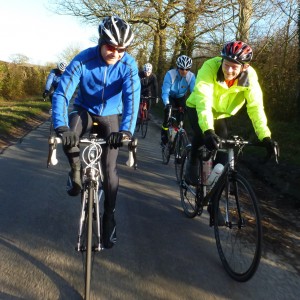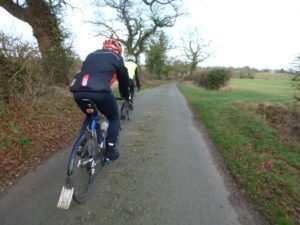To get started why not start by reading our notes to make sure you’re ready? This guide was written a few years ago now but remains relevant to riders who need a little advice to make the best of their riding.
Winter Training
For those members who are new to the rigors of winter riding, below are a few tips and guidelines to make your training runs more enjoyable. Much of it is common sense but it is surprising how many experienced riders still come out ill-equipped and under-prepared for winter conditions. If these guidelines are followed you should be entirely self sufficient and will not have to rely on other riders because of your lack of preparation.
The Bike
Your winter bike should be well maintained with operative brakes, good puncture resistant tyres, a functioning drive system and fitted with mudguards. Although the guards will protect you and your bike they will not stop your fellow riders from being sprayed with muddy water so a rear MUDFLAP is also essential. Regular checks of your tyres for cuts and flints will help avoid punctures and a bit of spray lube on the chain, derailleur and cables immediately after a wet ride will prevent costly repairs. Try to set up your training bike as closely to your race bike as possible i.e. same saddle height, saddle set back, drop to bars, reach, bar width, crank length.
Equipment
Regardless of the length of ride you think you will be doing, always bring the following so that you are prepared in the event of a change of plan.
-
- 2 Water Bottles: On a 3 hour ride, even in the winter, you should consume two large bottles of fluid.
-
- Waterproof cape: For the occasional shower and as an extra layer. This should be easily accessible, as close fitting as possible to avoid undue drag and breathable or you’ll end up soaked with sweat.
-
- Helmet: The likelihood of an accident in which a helmet would be of use is greater when riding in a group particularly in slippery riding conditions so although not compulsory, a properly adjusted helmet is recommended.
-
- Pump: Check regularly that it is fully operative and ensure it is securely attached to your bike and capable of inflating your tyre to 100psi QUICKLY! Full length frame fit ones such as the Zefal HPX are best.
-
- Tool Kit: If your bike is regularly maintained, the tools you need to carry with you should be minimal however, you should always bring the following items just in case: two spare tubes (make sure they aren’t punctured, have the correct valve length for your rims and are protected in a thick poly bag), Tyre levers (the brightly coloured plastic ones made by Tacx are best), a puncture kit (Park’s self adhesive patches are great for outdoor repairs but conventional feather edge vulcanised patches, when properly applied, are more permanent. A small multi-tool with 4, 5, 6mm hex keys and a screwdriver occasionally comes in handy as does a spoke key and a reel of insulation tape. Practice changing a tube quickly so you do not keep the rest of the group waiting unnecessarily in the cold. A small amount of money is also a good idea, in case of emergency or an unexpected café stop.
-
- Food: Even if you are using an energy drink as your fuel source, bring some emergency rations such as a flapjack or a gel as well in case you need a boost to get you home. An effective home made energy drink can be made from a 50/50 mix of orange juice and water with a desert spoon of brown sugar and a pinch of sea salt dissolved into it. If you prefer solid food then ripe bananas, dried fruits, fruit cake, fig rolls or white bread sandwiches with honey, jam or peanut butter are all good choices but make sure that whatever you have it can be unwrapped and consumed safely whilst riding.
-
- Clothing: Check the weather forecast before leaving and dress appropriately taking wind chill into account and paying particular attention to your knees and lower back. A fast wicking base layer is a must as is a close fitting shower proof cape which can be carried as a spare layer.
-
- Group Riding: When riding in a group, it is essential to concentrate on what is going on around you. The bunch should be a compact unit with riders two abreast and less than a foot (30cm) apart. Alert others to hazards such as potholes and parked or oncoming cars both by shouting and pointing them. Try to ride as smoothly as possible avoiding sudden accelerations, braking or swerving. Always ride slightly to one side of the rider in front so that if he slows you can easily overlap wheels rather than having to brake sharply. Avoid riding out of the saddle when in a group as your bike will tend lunge backwards slightly as you stand which may cause a touch of wheels. Finally, if you are on the front of the group, keep pedaling especially when going downhill.
-
- Belgian Circle: Not a cake but an effective method of riding in larger groups whilst giving everyone an equal workout. We don’t always do it! This involves two lines of riders with those on the side protected from the wind constantly overtaking the other line then moving over to join the windward side, drifting to the back again then moving over again to join the sheltered overtaking line. The technique requires a little more concentration than normal bunch riding but is worth practicing particularly if you intend to road race and is soon picked up when riding with an experienced group. The key thing is to ride as smoothly possible trying to maintain a tight formation so that everyone gets maximum shelter. There should not be a noticeable acceleration as you overtake to become the lead rider or when you move from one line to the other at the back. If using this technique on an endurance training ride, it is important to maintain the correct level of intensity (conversation is still possible) as it is all too easy increase the effort significantly without realising.
-
- Getting Home: If you are new to 3 hour winter rides or are returning from illness / injury then build up the length of your rides gradually over a period of weeks. Don’t let your training level be dictated by others. If you are struggling a little then sit in rather than continuing to take turns on the front until you are unable to keep up and if the pace is always too high for you to comfortably stick with the group then try to organise another group with riders of a similar ability. When you get back from a ride you should feel slightly fatigued but not utterly exhausted. Eat a small high sugar snack as you get home then shower, stretch and eat a well balanced meal and rest so that your body recovers and benefits for the training.


